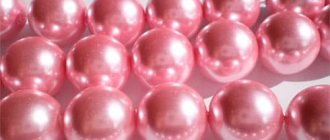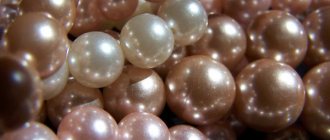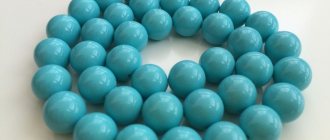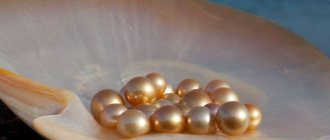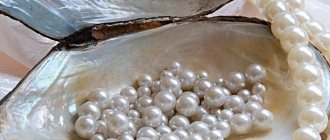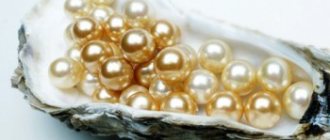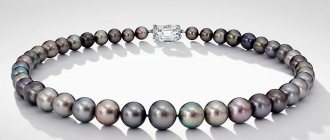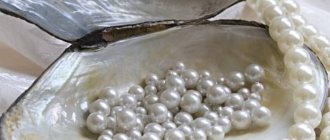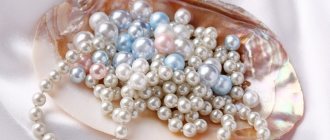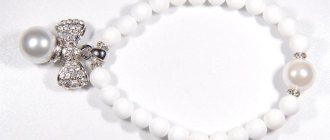| Stone type | Precious, semi-precious |
| Prevalence (Deposits) | Mexico, Panama, India, Tahiti, Sri Lanka, Japan, etc. |
| Varieties | Acoya, Baroque, Mabe, Mallorca, Oceanic, Freshwater, Tahiti, South Sea |
| Transparency | Translucent, opaque |
| Shine | Pearl |
| Mohs hardness scale | 3—4 |
| Chemical composition | CaCO3 |
| Color | White, blue, yellow, gold, pink, gray, black |
| Owner's color type | Spring, winter, autumn |
| Owner's temperament | Melancholic, Sanguine |
| Names | Andrey, Boris, Valentina, Galina, Eva, Evgeny, Evdokia, Inna, Irina, Claudia, Lilia, Margarita, Nadezhda, Oleg, Rosa, Sergey, Sofia, Elina, Yuliana |
| Zodiac sign | Libra, Cancer, Pisces |
| Date of Birth | from June 22 to July 22 from September 23 to October 23 from February 19 to March 20 |
| Chinese horoscope | Rabbit, horse, dog |
| Element | Water, Air |
| Planet | Neptune |
| Day of the week | Monday |
| Month | June, July, November, February |
| Season | Winter, summer, autumn |
| Numerology vibration | 2, 6, 7 |
| Chakra | Vishuddha, Sahasrara |
| What stones is it compatible with? | Aventurine, aquamarine, amethyst, turquoise, diamond, heliodor, heliotrope, garnet, emerald, moonstone, opal, rose quartz, ruby, chrysoprase, zircon, jasper |
| What stones is it not compatible with? | Beryl, malachite, sardonyx |
| Therapeutic effect (problems) | Blood pressure, vision, immunity, nervous disorders, memory and mental abilities |
| Therapeutic effect (on organs) | Organs of the gastrointestinal tract |
| Magic properties | Spiritual development, deception, strengthening relationships, black magic |
Pearls stand out among precious stones because they are not extracted from the bowels of the earth. The process of its formation is unique and has no analogues. A pearl in a shell is a real miracle of nature, which takes a lot of time to create. This is the reason for its high cost and demand among jewelers.
Origin of sea and freshwater pearls
Calling pearls a stone can be quite arbitrary. It is a mineral of organic origin that can be found in both marine and fresh waters.
According to the method of formation, pearls are divided into wild and cultured. A natural mineral created in natural conditions is quite difficult to find. Out of several hundred shellfish, only one can contain a precious pearl. Previously, this method of extraction caused irreparable harm to marine fauna, which led to its complete ban in the world since 1952.
In the modern market for precious materials, all pearls are cultured. The process of its formation completely copies natural “technology” with the difference that the core does not enter the mollusk’s mantle by accident, but with the help of humans. Another difference is the growing conditions.
Be sure to check out: Sapphire and ruby corundum: main differences from natural stones
Thus, natural sea pearls are formed in the body of bivalve sea mollusks. It matures longer than its river counterpart, often has a more even spherical shape and unique shades.
Its freshwater “brother” is formed in the mantle of freshwater oysters. It is distinguished by a thicker mother-of-pearl layer, oval shape, high strength and moderate cost. The most common color of the river mineral is milky white.
Interesting! One freshwater shell can grow 13-15 pearls.
HOW ARTIFICIAL PEARL IS MADE
Cultured pearls are made without a shell and are not related to shellfish. These beads are distinguished by a rich palette of shades, rainbow tints and shine.
Majorca
The jewelry company Majorica produces the organic material by coating frosted glass with numerous layers of a substance obtained from the mother of pearl of the shell. Each layer is polished to achieve the perfect shape. It takes from 10 to 30 days to create one pearl.
Taraka
The formation mechanism of this product consists of two stages:
- First, a bead is made from mother-of-pearl removed from the inside of the shell.
- Then it is coated with polyamide and varnish.
Such pearls are quite durable, unlike natural ones, and have a beautiful shine.
France
This forming method is one of the oldest, used since the 16th century. Making French beads involves filling blown glass beads with wax (for weight).
What mollusks produce pearls
Only mollusks capable of producing mother-of-pearl are important for industry. These include bivalves, gastropods and cephalopods.
Akoya oysters can be found off the Japanese islands or in the waters of the South China Sea. The pearls they produce are distinguished by a thin layer of nacre and amazing brightness, for which they are so valued. The largest ones do not exceed a diameter of 1 cm, and the predominant shades are cream, milky and pink.
A special type of shellfish, Pincatada Maxima, is grown in the coastal waters of Australia, Indonesia and the Philippines. They produce some of the largest pearls (up to 20-22 mm in diameter) with the thickest nacre layer. South Sea pearls (second name) are interesting for their unusual types of shades (golden, pink, silver-gray) and moderate matte shine.
The island of Tahiti is famous throughout the world for its unusual black pearls, which are formed in large Black-lipped oysters. The name “black” is very arbitrary, since the natural shade of the mineral can vary from blue to dark purple.
Unionids are responsible for the production of the freshwater species. These pearl oysters are capable of growing material of a wide variety of colors. An additional feature is resistance to temperature fluctuations. The main exporter of the river variety is China.
The process of pearl formation in a mollusk shell?
was known to scientists in general terms. Now there are new ones... Published by Torgfort_vl Sunday, February 10, 2022
What determines the appearance of pearls?
What will the pearl be like in its shape, color and size? This is influenced by a lot of factors.
Small pearls live in rivers and other small bodies of water, and larger ones live at the bottom of the sea. If a mineral grows on the body of a mollusk and does not touch the inner walls of the shell, it is most similar to a ball. Moreover, it can form on the sink and resemble a growth.
The diameter of the smallest pearls reaches 0.2 - 0.25 cm, the largest - more than 0.8 cm. Rarely, but in nature, stones 1 cm wide are still found. The most impressive find can be seen in the London Museum: its weight is 85 grams , and the girth is 4.5 cm.
Jewelry stores offer pearls in a variety of colors - for example, white, pink, silver, blue, black and even burgundy.
The most expensive are blue gems, which are mined in the Indonesian depths. Dark pearls are mined in the Caribbean, golden pearls in Panama, white pearls in Australia, and pink pearls in Japan and India.
Wild pearls
The fruits of nature's labor occupy a small part of the market. Extracting them is difficult and harmful to the ecology of the underwater world. However, many treasure connoisseurs are uncompromising - they do not agree with artificial stones, even if they are masterfully grown.
In search of precious specimens, you need to check a huge number of shells: in only 1 out of 10 you can find a mineral with suitable dimensions to be used in jewelry. However, fans of unusual jewelry often like stones with a non-standard shape. Fortunately, their variety is impressive - they can be not only oval, but also of all sorts of fancy shapes. Mother-of-pearl shimmers mesmerizingly on the curves, and some stones seem to be surrounded by rings.
Varieties of natural pearls with irregular shape:
- Keshi in the shape of a petal.
- Biwa resembles a mother-of-pearl stick.
Matte pearls look very impressive: this anomaly is associated with the absence of mother-of-pearl particles and costs fabulous money. This is an absolute exclusive, and it is unlikely that you will find the same decoration on anyone on Earth.
Is it possible to tame pearls?
The greatest demand for jewelry with pearls is pushing jewelers to artificially grow gems. A foreign particle is specially placed in the shell - as a rule, it is a polished piece of the pearl itself. After which the shell is lowered into the pond, where optimal conditions for incubation are created.
Cultured pearls are the same as natural stones. With the help of well-established production, it is possible to obtain minerals with certain parameters. Various types of bivalve mollusks are cultivated on special plantations.
Nuclear method of pearl cultivation
A seed is placed into the oyster - a small sphere taken from a freshwater pearl mussel.
This method is quite expensive, as there is a risk of seed rejection. If a foreign body “takes root” in the shell, organic and mineral layers are alternately layered on it. This way you can get a perfectly round pearl or a stone that is as close in shape as possible.
If the seed is large, the pearl turns out to be large, but it cannot be called natural. Almost all Chinese gems larger than 8 mm are produced using this method. They are quite affordable, but after 3 to 5 years they are destroyed. All that remains is the original seed.
There are hundreds of mineral farms in Thailand, China and Malaysia. So a shell with a pearl is considered a wonderful souvenir here.
Nuclear-free cultivation method
It is actively used on freshwater farms. The smallest grains of sand are used as seeds, and after a few years pearls are born from them. The result is small stones that are practically indistinguishable from natural ones.
Pearls were first cultivated in China - this happened a couple of centuries ago. To this day, the Celestial Empire, like Japan, is considered the leader of the “pearl market”. Over several centuries, biologists have learned to grow different types of pearls:
Akoya
The pearls get their name from the oysters from which they are grown. Sea pearls from Japan and China are the most common type with a classic shape and color. Its dimensions are no more than 0.8 cm, and light is refracted inside in an amazing way, creating a magical glow.
Golden pearls
It is cultivated in the seas of Indonesia and Australia, as well as in the Philippines and Myanmar. It has noticeable differences from oriental gems: its diameter is up to 1 cm, and the top pearlescent layer is so dense that the shine looks muted.
Black Pearl
Its homeland is Tahiti, but today the production of this unique stone is widespread in many parts of the world. These are royal pearls, which can have different sizes - from 0.8 to 1.8 cm - and are very expensive.
The color range is extremely diverse: from silver to black, with blue, purple or green tints.
White pearls
Born in silver-lipped oysters, it is found in Indonesia, Australia and the Philippine Islands. Its diameter can be 2 cm.
Silver-lipped oysters are extremely capricious, and not everyone can tame them. So the stones turn out to be expensive and exclusive.
The shape of the mineral depends on where exactly the foreign body is introduced:
- circle or sphere
- hemisphere
- rice
- a drop
- baroque
- semi-baroque
These gems are real value. They appear in the very heart of the shell - clearly in the center.
Just as valuable and widely used in jewelry as round gems;
Due to contact with the walls of the shell, the pearls are flattened and resemble grains of rice.
Stones with an ideal shape for making pendants, earrings and pendants.
An interesting stone with an abstract shape. There are such specimens that are valued even more expensive than round ones.
In this case, the shape resembles a round one, but there is no symmetry.
Merchants determined how ideal a spherical stone was even without special equipment. They rolled the gem along the surface at an angle. Those samples that rolled “just right” were called “rolled pearls.”
Cultured pearls
Artificial stones are not born in oysters, but the hands of an experienced jeweler and modern technology can work wonders. And today they are becoming increasingly difficult to distinguish from natural ones.
There is historical evidence that imitation pearls existed back in the Middle Ages - then they were created from fish scales. But today, technology is such that imitation stones (if they are of high quality, of course) almost keep up with natural ones.
In Chinese street markets you can watch the cultivation of artificial pearls. Gullible tourists often buy them, considering them natural, so you should be more careful.
The most common types of artificial minerals:
Majorca
The base of the stone is glass or plastic, with an artificial mother-of-pearl coating on top. Due to the unique method of surface treatment, these pearls are difficult to distinguish from cultured ones.
Taraka
At the base of the stone is real mother of pearl, taken from the inner lining of the shells. The surface of the stone is treated with varnish and polyamide, due to which the pearls acquire even greater shine.
French stones
The wax fills the glass ball from the inside, which becomes like a pearl.
Venetian
The same as the French ones, only with the addition of pearl dust on the glass of the sphere.
How pearls are formed in a shell in nature
The process of pearl formation is unique and has little in common with the formation of other types of precious materials. In nature, it can take more than a dozen years. As for the artificial environment, people have learned to recreate optimal conditions that completely copy the natural process, but at the same time make it possible to shorten the growth period.
The structure of a pearl is a core and a shell. The center can be a piece of stone, a grain of sand or an insect. Getting inside a sea shell, a foreign body causes irritation of nerve fibers. As a result, the epithelium of the mollusk begins to actively divide, and the mantle begins to produce a special substance - nacre, which slowly covers the core.
Most often, a pearl is formed on a thick section of the mantle or on the muscle responsible for closing the shell valves. According to observations, in the first case the mineral acquires spherical contours, and in the second - an irregular but original shape.
What does a pearl consist of and how does it grow?
The basis of any pearl is the core. In the wild, it is of natural origin, however, in conditions of artificial cultivation, it acts as a small ball.
Be sure to watch: Assessing the purity and quality of diamonds: characteristics and tables
After irritation of the nerve endings, the core begins to be enveloped in aragonite and calcium carbonate, which are part of the mother-of-pearl. Gradually, more than a hundred layers of this substance grow on the mineral and thus a natural pearl gradually grows in the shell.
The process and features of the formation of natural pearls
Formation of pearls
Many people know what pearls are and what they look like, but not everyone knows how pearls are formed in a mollusk. Sometimes foreign bodies get into the slightly open shell flaps: grains of sand, organic matter, small pebbles. The mollusk is a very delicate creature and any irritant can damage its body, so it has to protect itself. To reduce the irritating factor and save its life, the mollusk begins to secrete a certain secret that envelops the foreign object that has entered it. Shell after shell, protection increases against particles that fall into the shell until all its sharp corners are smoothed out. The more time this happens, the larger the pearl eventually grows.
The chemical composition of nacre is 90% calcium carbonate, 5% water and the same amount is conchiolin, an organic protein substance needed as a binding material.
The first layer of aragonite forms around the foreign body, which is covered with another hundred layers. The void between the calcium carbonate crystals is filled with proteins, which give the shell strength. In the top layer there is only aragonite, which causes a beautiful shine.
The appearance of natural pearls in natural conditions is desirable for fishermen of this unique mineral, but not for the mollusk itself. For him, this is stress and desperate attempts to protect himself from an unwanted guest. But, one way or another, all the shells will inevitably die, because... When harvesting pearls, each of them is opened.
How long does it take for pearls to grow and mature?
If natural processes take several decades, then people are not used to waiting so long, and having improved production technologies, they have significantly shortened the ripening period of the precious material.
The Birth of a Pearl
The shell is a natural refuge for the oyster. The inside of its doors are covered with a thin layer of mother-of-pearl, which performs protective functions similar to the human immune system.
Interesting! When a foreign particle enters, the secretion of nacre is activated, and the process of isolating the irritant begins by enveloping it in an aragonite layer. The more layers are formed, the more harmless the “stranger” will become for the oyster. Over time, the rate of nacre secretion will slow down, but its secretion will continue throughout the life of the mollusk.
How long does a pearl grow?
On average, pearls are grown on farms in 2-3 years, while in nature they grow for at least 7 years. The most active growth rates can be observed in the first year. The built-up layer of mother-of-pearl is 2 to 3 mm thick. Further, the rate of layer formation decreases significantly.
Most freshwater mollusks can produce more than 40-50 pearls during their life; in marine varieties, the maximum number is limited to 3-4 pieces. Despite the fact that the growth period of the latter is longer, the resulting result compares favorably with size, color quality and thickness of the pearlescent layer.
The size of the pearl also depends on the age of the mollusk. The younger it is, the larger the ripened mineral will be.
Pearl of Allah The largest natural pearl was found in 1934 on the Philippine island of Palawan...
Published by 585.ua Wednesday, July 18, 2022
Education by artificial means
The formation of cultured pearls differs from the natural process only by human intervention at the stage of placing the nucleus in the shell.
The industrial cultivation technology was patented back in 1896 in Japan. Today, by changing the conditions (the type of nucleus, its location in the shell, the composition of the water), it is possible to obtain pearls of different shapes, sizes and colors.
Mechanism of pearl formation
The principle of formation of cultured pearls is no different from the process occurring in the wild. The implant may be a piece of shell, beads, or a synthetically created core. The best option is a pearl ball, which more actively stimulates the secretion process in mollusks.
The shell flaps are opened, an incision is made into the mantle using special instruments, and an implant is placed in the resulting pocket. Further growth of the mineral will depend on the following factors:
- type of mollusk and its age;
- chemical composition of water;
- ecological parameters of the environment.
A person carefully controls all these indicators, which allows him to achieve rapid growth.
Interesting! After the pearl is removed from the shell, the mollusk does not die. It is carefully cleaned and, after the mantle has been restored, used again for further dilution of the precious material.
Would you like to receive a pearl in a shell as a gift?
Not really
WHERE ARE PEARLS CULTIVATED?
Cultured pearls are obtained by growing on special plantations due to:
- introduction of an irritant that provokes the mollusk to secrete nacre;
- creating artificial conditions.
We recommend: AKOYA PEARLS: description, authenticity, cultivation
There are different methods for obtaining saltwater or freshwater cultured pearls.
Pearl farms
Huge garlands of shellfish are then suspended in a marine incubator on floats, where the precious material grows naturally. The shells are periodically turned over so that the mother of pearl is distributed evenly and the beads are perfectly spherical. Over the course of several years, real pearls appear in the oyster shell.
Pearl farms
Nuclear method
The formation of pearls can be with the use of a nucleus or without a nucleus. According to Japanese technology, introduced by the famous Mikimoto and patented in 1896, the shell flaps were slightly opened and small fragments of coral were introduced into it. Today, a mother-of-pearl ball made from the shell of a freshwater mollusk is used as a core.
Nuclear-free method
The birth of pearls can also be nuclear-free. In this case, pieces of the epithelium (epidermis) of another mollusk are introduced into the connective tissue of the mantle of one mollusk, as described above. The mortality rate of mollusks with a transplant ranges from 10 to 40%. If everything went well, the individual is placed in an incubator and waits for the jewel to appear.
Types of cultured pearls
In nature, pearls occur in several shades. Reddish, dark brown and violet-black material is found in the noble pinna. In addition, different mollusks form different pearls:
- abalone - oval white and blue-green with a strong shine;
- common chalk - round yellow-orange;
- buccinum vulgaris - pale colored;
- gastropods - shiny.
Haliotis
They cultivate mainly white, black, gold and akoya.
Akoya
This species is grown in the bivalve shells of mollusks of the genus Pinctada, the Japanese call them “akoya-kai” - hence the name. The characteristics of the material are as follows:
- size - 6-8 mm;
- cultivation - 1-4 years;
- color - pearlescent pink, pearlescent white, cream, rarely silver, silver-green.
The shape can be different, the ideal one is spherical.
Akoya
Gold
Golden pearls are formed in the pinctada maxima oyster, which lives in a small Pacific bay. The plantation for the cultivation of this material is located near the island. Palawan. It takes 5 years to mature.
We recommend: BALTIC AMBER mining for private owners
Black
Pearls of this color are cultivated near the island. Tahiti, Cook, Marshall, Vietnam, Fiji, Micronesia, Australia in the shell of the mollusk Pinctada margaritifera. Drop-shaped shape up to 15 mm long.
Mollusk Pinctada margaritifera
White
The giant tridacna has shells that lack nacre and produces pink and milky white pearls. Therefore, these mollusks are used to grow it.
What determines the shape and color of pearls
The shape and color of the mineral is determined by a number of conditions. When the pearl is fixed in the shell without contact with its walls, the shape will be perfectly spherical. If the core is attached to the shell, then the contours will be close to teardrop-shaped. Irregularly shaped pearls are also obtained when an implant is placed in the muscular part of the oyster, and when the mineral is formed at the surface of the valve, blister pearls are born - the cheapest type of pearl.
The color depends on the type of mollusk. Black lipped oysters from the Caribbean islands most often produce spectacular dark smoky and black pearls. Japanese Akoya clams are elite pink pearls with a perfectly round shape, and Panamanian sea shells are famous golden pearls. The most expensive blue pearls in the world are grown on the islands of Indonesia and Mexico, in Black-Lipped Oyster shellfish.
Factors affecting growth rate
How long it takes for pearls to form depends on many factors. An important one is the type of mineral. Freshwater pearls grow at the bottom of rivers and lakes for at least 2 years. During this time, the mother-of-pearl layer is up to 3 mm, but after 10 years its thickness can reach 1 cm.
Also, the ripening time depends on the type of pearl mussel, its age, habitat and environmental factors. The largest specimens mature in young shells. With age, the pearl oyster's mantle becomes depleted, and small pearls form in the shell. Pearls grow fastest in the first year. Further, its development slows down from 2.5 mm to 0.38 mm per year.
The average lifespan of one pearl is only 150-200 years. To preserve the beauty of the stone, it must be regularly moistened, storage conditions observed and protected from exposure to active chemicals. But no matter what quality conditions pearls are kept in, over time they age, delaminate and lose their shine.
Main conclusions
Knowing where pearls come from, you can take a fresh look at such familiar jewelry made from this material.
- The harvesting of “wild” pearls has been prohibited in the world since 1952.
- All modern products are made from human-cultivated material.
- There are freshwater and saltwater pearls.
- When growing pearls, nuclear and non-nuclear technology is used.
- The special pearl qualities (color, shape, size) depend on the cultivation conditions and the type of mollusks used.
Modern production methods make it possible to create minerals identical to natural ones in a wide variety of shades and shapes without harm to the environment.

